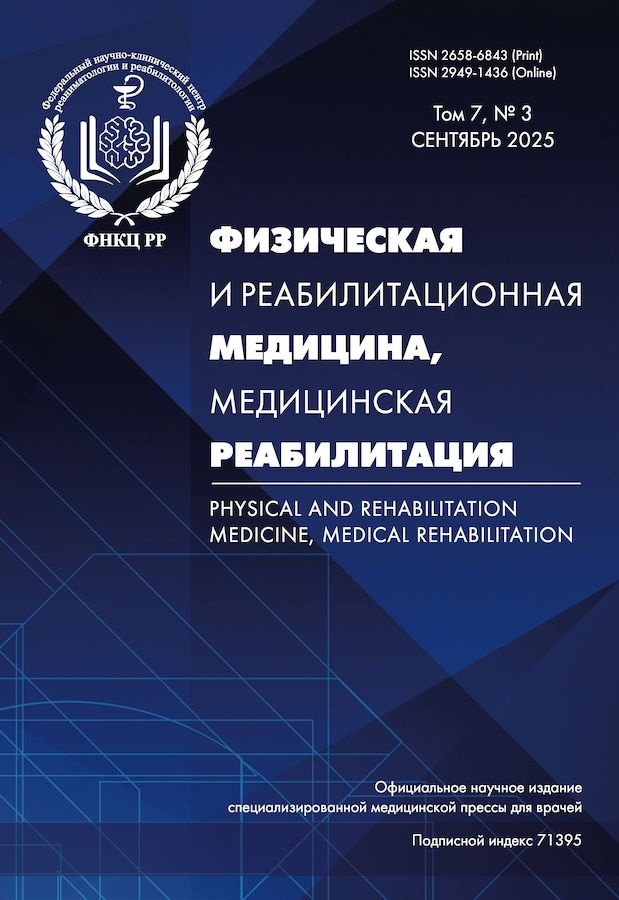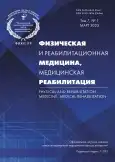Dynamic assessment of cardiovascular system functioning indices and adaptive potential in patients after ischemic stroke during rehabilitation
- Authors: Ivanov K.P.1,2, Dolgikh V.T.3
-
Affiliations:
- Federal Research and Clinical Center of Intensive Care Medicine and Rehabilitology
- Institute of Biomedical Problems of the Russian Academy of Sciences
- Omsk State Medical Academy, Ministry of Health of Russia
- Issue: Vol 7, No 1 (2025)
- Pages: 24-36
- Section: ORIGINAL STUDY ARTICLE
- URL: https://bakhtiniada.ru/2658-6843/article/view/288225
- DOI: https://doi.org/10.36425/rehab642276
- ID: 288225
Cite item
Full Text
Abstract
BACKGROUND: Stroke is the leading cause of primary disability, necessitating the search for new approaches to evaluating restorative treatment in patients with acute cerebrovascular events. Such approaches would facilitate the more effective implementation of medical rehabilitation measures. Studying of the dynamics of cardiovascular system dysfunction during ischemic stroke, determination of the potential for optimizing restorative treatment, and improvement of rehabilitation measures will enhance the clinical and social prognosis for patients, improve their quality of life, and reduce the incidence of complications and mortality.
AIM: To evaluate the functional state of the cardiovascular system and its adaptive potential at the second stage of rehabilitation in patients after ischemic stroke.
MATERIALS AND METHODS: Sixty-six patients aged 41 to 82 years underwent the second stage of rehabilitation after ischemic stroke, with an assessment of the functional state of the cardiovascular system. Holter electrocardiogram and blood pressure monitoring was performed on the first and tenth days of rehabilitation treatment. The analysis included blood pressure and heart rate. The changes in cardiovascular system function and adaptive potential were assessed using cardiovascular system function indices.
RESULTS: An integral assessment of the functional state of the cardiovascular system demonstrated mobilization of the body’s adaptive capabilities during rehabilitation. A gradual decrease in systolic and diastolic blood pressure was noted, along with improvements in pulse pressure parameters, the functional change index, adaptive potential, Kerdo’s vegetative index, Robinson’s index, and endurance coefficient. A positive trend in cardiovascular system function was observed in 83.3% of cases (n=66). Women demonstrated better progress in circulatory system performance compared with men.
CONCLUSION: During post-stroke rehabilitation, the use of integral indices to assess the functional state of the cardiovascular system is relevant and pathogenetically justified. A distinct positive trend in functional values and an increase in the adaptive potential of the cardiovascular system were observed, confirming the effectiveness of the rehabilitation measures taken. The proposed assessment methods may be useful for monitoring the effectiveness of rehabilitation in patients after ischemic stroke.
Full Text
##article.viewOnOriginalSite##About the authors
Kirill P. Ivanov
Federal Research and Clinical Center of Intensive Care Medicine and Rehabilitology; Institute of Biomedical Problems of the Russian Academy of Sciences
Author for correspondence.
Email: kpivanov95@gmail.ru
ORCID iD: 0009-0000-9569-2246
SPIN-code: 5917-7650
Russian Federation, Moscow; Moscow
Vladimir T. Dolgikh
Omsk State Medical Academy, Ministry of Health of Russia
Email: prof_dolgih@mail.ru
ORCID iD: 0000-0001-9034-4912
SPIN-code: 2052-1445
MD, Dr. Sci. (Medicine), Professor
Russian FederationReferences
- Piradov MA, Maksimova MY, Tanashyan MM. Stroke: Step-by-step instructions. Manual for doctors. Moscow: GEOTAR-Media; 2019. 272 р. (Series: Medical Specialist Library). (In Russ.) doi: 10.33029/9704-4910-3-ins-2019-1-272 EDN: ZAMTOP
- Alferova VV, Belkin AA, Voznyuk IA, et al. Clinical recommendations for the management of patients with ischaemic stroke and transient ischaemic attacks. Stakhovskaya LV, editor. Moscow; 2017. 196 p. (Library of practical doctor, series ‘Neurology’). (In Russ.) EDN: ZNFMEF
- Kuriakose D, Xiao Z. Pathophysiology and treatment of stroke: Present status and future perspectives. Int J Mol Sci. 2020;21(20):7609. doi: 10.3390/ijms21207609 EDN: WVJJPP
- Chamorro Á, Dirnagl U, Urra X, Planas AM. Neuroprotection in acute stroke: targeting excitotoxicity, oxidative and nitrosative stress, and inflammation. Lancet Neurol. 2016;15(8):869–881. doi: 10.1016/S1474-4422(16)00114-9
- Khoshnam SE, Winlow W, Farzaneh M, et al. Pathogenic mechanisms following ischemic stroke. Neurol Sci. 2017;38(7): 1167–1186. doi: 10.1007/s10072-017-2938-1 EDN: AUZPFB
- Wafa HA, Wolfe CD, Bhalla A, Wang Y. Long-term trends in death and dependence after ischaemic strokes: A retrospective cohort study using the South London Stroke Register (SLSR). PLoS Med. 2020;17(3):e1003048. doi: 10.1371/journal.pmed.1003048 EDN: GAAVGW
- Powers WJ, Rabinstein AA, Ackerson T, et al. Guidelines for the early management of patients with acute ischemic stroke: 2019 update to the 2018 guidelines for the early management of acute ischemic stroke: A guideline for healthcare professionals from the American Heart Association/American Stroke Association. Stroke. 2019;50(12): e344–e418. doi: 10.1161/STR.0000000000000211 EDN: QSMWGB
- Piradov MA. Strokes. In: Gelfand BR, Zabolotsky IB, editors. Intensive therapy. National manual. 2nd ed. Moscow: GEOTAR-Media; 2017. Р. 288–309. (In Russ.)
- Rost NS, Brodtmann A, Pase MP, et al. Post-stroke cognitive impairment and dementia. Circ Res. 2022;130(8):1252–1271. doi: 10.1161/CIRCRESAHA.122.319951 EDN: WUIFUK
- Abdurakhmonova RF, Izzatov KhN, Faizullaev AKh, Tursunova MSh. The effectiveness of complex neuroprotective therapy in the acute period of stroke. Vestnik poslediplomnogo obrazovaniya v sfere zdravookhraneniya. 2019;(4):98–105. EDN: AALHFC
- Baevsky RM, Berseneva AP. Assessment of adaptation capabilities of the organism and the risk of disease development. Moscow: Meditsina; 1997. 235 р. (In Russ.)
- Repalova NV, Avdeyva EV. Change in the adaptive potential of the cardiovascular system in foreign students under pre-examination stress. International journal of applied and fundamental research. 2021;(4):12–16. doi: 10.17513/mjpfi.13197 EDN: LLJJGL
- Ivanov SA, Nevzorova EV, Gulin AV. Quantitative evaluation of functional capability of cardio-vascular system. Tambov university reports. Series: Natural and technical sciences. 2017;22(6-2):1535–1540. doi: 10.20310/1810-0198-2017-22-6-1535-1540 EDN: YRNTTB
- Patent RUS № RU 2314019 C2. Konevskikh LA, Oranskij IE, Likhacheva EI. Method for evaluating adaptation potential. Available from: https://yandex.ru/patents/doc/RU2314019C2_20080110?ysclid=m7gkma2d41766214641 Accessed: 15 Feb 2025. EDN: JZOVXO
- Yusupova NZ, Lyadova IV, Khairullina LR, Frolova OA. Assessment of the functional state of the organism of public catering workers. Vestnik novykh meditsinskikh tekhnologii (Electronic edition). 2023;17(2):98–104. doi: 10.24412/2075-4094-2023-2-2-4 EDN: RVCKBJ
- Tarabrina NYu, Grabovskaya EYu, Tarabrina VA, Abduramamov AR. Manifestation of the main indicators of the central cardiohemodynamics in wrestlers of different qualification. Scientific Notes of V.I. Vernadsky Crimean Federal University. Biology. Chemistry. 2018;4(1):92–103. EDN: YWXVUO
- Mokasheva EkN, Mokasheva EvN, Grebennikova IV, et al. Rapid assessment of cardiovascular system parameters using cardiorespiratory indices. Advances in current biology. 2023;143(2): 144–150. doi: 10.31857/S0042132423020072 EDN: KMGQMJ
- Milyutin SG, Sysoev VN, Borisov AM, et al. Dynamics of physiological levels of functional status of medical students in adapting to learning. Sovremennye problemy nauki i obrazovaniya. 2013;(2):103. EDN: RXUNPL
- Bekmuradova MS, Khaidarov SN. Relation between increased pulse pressure and natriuretic peptide. Journal of cardiorespiratory research. 2022;3(1):26–29. (In Russ.)
- Kobalava ZhD, Konradi AO, Nedogoda SV, et al. Arterial hypertension in adults. Clinical guidelines 2020. Russian journal of Cardiology. 2020;25(3):149–218. doi: 10.15829/1560-4071-2020-3-3786 EDN: TCRBRB
- Dyomko AI, Almazova EG, Semenov OYu. Measurement and statistical processing of pulse time parameters. Bulletin of cybernetics. 2020;(3):34–45. doi: 10.34822/1999-7604-2020-3-34-45 EDN: IVYTNP
- Lang TA, Sesik M. How to describe statistics in medicine: Guidelines for authors, editors and reviewers. Transl. from English, V.P. Leonov, editor. Moscow: Prakticheskaya meditsina; 2011. 477 р. (In Russ.) EDN: QLYKNZ
- Khursa RV. Pulse pressure of the blood: Role in the hemodynamic and applied possibilities in functional diagnostics. Medical news. 2013;(4):13–18. EDN: QABMVJ
- Tulyakova OV, Avdeeva MS, Smirnova AA. Functional state of students in the first year of study. Novye issledovania. 2021;(3):40–45. (In Russ.) EDN: OWHVIE
- Lazidi GKh. Method of detection of early symptoms of cardiovascular insufficiency in patients with chronic nonspecific lung diseases. Kardiologiia. 1972;12(7):45–52. (In Russ.)
Supplementary files








